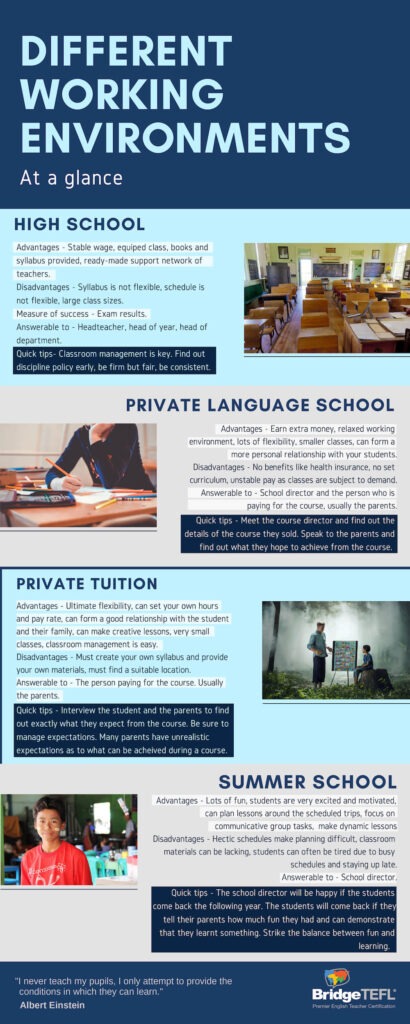There’s a common myth about teaching ESL to teenagers: They’re more difficult to teach than children or adults because they’re not interested in learning. As an experienced teacher of kids and teens in the U.S. and now China, I can tell you that this notion is simply untrue. Yes, you may have to work harder to earn the attention of students in this age group, but I’ll give you pointers on how to teach teens ESL, including unique teaching strategies, engagement methods, and much more that will keep your students focused on learning all year.
If you’re new to teaching, you’ll want to get initial training and qualification with a TEFL certificate. You can explore our online TEFL courses to get started!
Where in the world is it common to teach ESL to teenagers?
First, you might be wondering if, as an English teacher, you will even teach teenage students. Well, even if you didn’t set out to teach this age group, if you plan to teach EFL abroad or online, chances are that you will. That’s because in many countries of the world, it’s very common to teach both kids and teens. Let’s look at the regions where this is the case.

Richard, with his teenage students in Thailand
Asia
Asia is by far the most common region in the world to teach English to teenagers. Specifically, countries such as China, South Korea, and Thailand seek qualified ESL teachers to teach young students in order to meet the demands of the countries’ strong emphasis on English language acquisition. These countries generally have great salaries and benefits for English teachers, which, when paired with the low cost of living, makes Asia (and, therefore, teaching young learners and teens) a popular choice for many teachers.
Europe
The next region where it’s most common to teach teenagers is Europe, including destinations such as Spain, Italy, the Czech Republic, and Ukraine. Students in these countries are often a mixture of teenagers and young learners, and English summer camps are common here, too. Teachers who are drawn to Europe by decent salaries and a chance to travel to surrounding countries should be prepared to teach teenagers.
Online
Teaching English online is an increasingly popular option for both new and experienced teachers since this type of job can be done from anywhere in the world, on a flexible schedule, and from the comfort of your living room. The typical student in these classes is generally a young learner, and that may include both children and teenagers whose parents enroll them in virtual classes after school to improve their English.
Whether in Asia, Europe, or elsewhere, you can find yourself teaching teenagers in a variety of work environments, including public or private K-12 schools, English language centers, private tutoring, or online.
This infographic from the Bridge Teaching Young Learners and Teenagers course outlines some of the possibilities.
To learn more about teaching kids and teens, check out Teaching English to Adults vs. Kids: What, Where, and Why.
What’s important to know about teaching English to teenagers?
Teaching English to teenagers can be difficult at times, but it should be viewed as a fun challenge for both you and your students.
Level of proficiency
The most important thing to understand about teaching teens is that, following years of prior learning, they’re often well advanced in their English proficiency. As a result, your job as the teacher is to challenge them in ways that will help them advance even further, rather than simply assess their already-developed language skills.
The teenage psyche
Further, the teenage psyche is very distinct from that of children or adult students. As Nicola Morgan, author of the best-selling book, Blame My Brain, an examination of the teenage brain, explains, teenagers are learning to handle and demonstrate their emotions appropriately, falling behind or surging ahead of their peers academically, and establishing their roles in the classroom’s “society.”
She emphasizes, among other things, that during teaching, we need to keep in mind that teenagers:
Take a look at some challenging types of online students and how to handle them.
What are some strategies for teaching teenagers?
With these characteristics of the teen psyche in mind, let’s look at some strategies that are effective with this age group.

Jody, teaching young adults in Costa Rica
Get to know your students.
Getting to know your teenage students on a personal level will yield great benefits in your classroom. Take the time, especially early in the school year, to learn what their interests, hobbies, talents, and even dislikes are. Then, use this information in your lessons! Students are much more likely to be interested in a lesson that relates to them in some way rather than something that means nothing to them.
Make use of classroom routines.
Classroom routines that are well-crafted and consistently followed create a predictable and comfortable learning environment for young learners and a natural “flow” to your lesson.
Your lesson will include certain elements every day, such as warming up, reviewing homework, presenting new material, and practicing concepts. Use visual or verbal cues to transition between these segments to allow students to develop familiarity with the daily class structure. As a result of routines, students are much more likely to come prepared to class, understand what is happening throughout a lesson, and maintain their focus during instruction.
However, also build opportunities to break away from the routine and implement an exciting new activity, instead!
Throughout your lessons, be sure to allow time for group work.
Teenage students are eager to speak to one another, so grouping four or five of them together is a clever way of allowing that to happen in a productive, academic way. Make sure to adhere to a strict, English-only policy in this setting!
Learn about other strategies for teaching English online to groups.
Lastly, when possible, stray from the classic “stick to the textbook” method of teaching.
Look for creative ways to engage your students. For example, when teaching a lesson on music, consider moving away from the textbook in favor of having students bring their own instruments and perform for the class, or let the students choose a song to use in a class activity.
Check out 5 popular ESL teaching methods you should know.
How do I prepare a lesson plan for teenagers?
Keep “relevancy” in mind.
What this means is that the materials you use and the topics you teach about should relate to the teenage students’ lives. While relevancy is important for teaching all ages, it is especially important for teenagers in order to motivate them.
In a rush? These last-minute ESL lesson plans can be adapted to any class.
Lesson plans for teenagers ought to be more activity-driven than anything else.
While children can effectively learn through playing simple games, activities you use with teenagers should provide them with an active, participative role in the learning process. Consider making common use of activities like role-plays, in which students can develop scripted dialogues about different topics and perform for the class.
Watch a teaching video from the 60-hour Bridge Specialized Certificate in Teaching Teenagers, showing a role-play in which the students use “realia.”
What are some ESL games for teenagers?
When choosing classroom games and activities for teaching ESL to teenagers, it’s important that you use advanced games so the teens don’t fret over feeling “childish.” The following are some effective games you can use with teenage students.
Games for in-person classes
English Only
In this challenging game, students compete to speak only English for the entire lesson; teams that speak their native language are marked with a point. The team with the fewest marks wins a prize.
Take a look at some fun ESL pronunciation games to incorporate into your class.
Hot Potato
This no-materials-needed classic is another game that teen ESL students enjoy. The students quickly pass a ball (or ball of paper) around the room while music plays. Use a popular song the students know and like to keep them engaged. The student holding the “hot potato” when the music stops has to answer a question correctly to earn a point.
Roll the Dice, Make a Question
In this game, the numbers one through six are written on the board corresponding to “Who, What, When, Where, Why, and How.” A student rolls the dice and then poses a question to a classmate based on the number the dice landed on.
ESL Songs
Beyond games, using music in the classroom is also a great way to help students learn while having fun. For more song activities and song suggestions, check out the teens section of this article: ESL Songs for Kids and Teens.
Games for the virtual classroom
Tell Me 5
The teacher picks a topic, e.g., animals, colors, verbs, etc., and the student whose turn it is must name five items in the category in less than a minute. This is a great way to review vocabulary!
Add these low-prep ESL games for teaching online to your repertoire.
Find Something That…
In this game, the teacher asks students to find an object that meets a certain description. For example, they can find something that’s blue, something that starts with the letter B, or something that is used in the kitchen. Students usually enjoy sharing objects from their homes.
Take a look at this 5-point checklist for planning online ESL games for teens.
Pictionary
Use a virtual whiteboard — or else hold up a physical whiteboard to the camera — to draw objects. Have students guess what you’re drawing. You can also have the students take turns being the artist, and you can even choose a theme to ensure they practice words that you want them to review.
Get more ESL game ideas in this Micro-credential course: Games and Activities for the Online Classroom (Teenagers).

Thai students in an ESL activity
What are some English conversation topics for teenagers?
Teenagers will typically be very capable conversationalists since they’ve often already had years of English study. As such, it’s a good idea to push them toward thought-provoking conversations instead of the more simple subjects used with children (i.e., avoid, “What’s your favorite sport and why?” in favor of “How does media affect the thinking patterns of people today?”).
This list of questions from The Internet TESL Journal provides plenty of inspiration you can use to get your class of teenagers talking, such as:
Take a look at some other TEFL discussion questions for older students.
What’s the best way to motivate adolescent students and keep them engaged?
Build relationships with your students.
While they will never (or, rarely) admit it, teenage students love when the attention is on them. Use this to your advantage by demonstrating a genuine investment in who they are as people and as students.
Learn how to build rapport with students when teaching English online.
Use rewards as motivation.
A good teacher knows which motivational buttons to push with teenage students, such as offering rewards for good behavior, and when to push them. Often, a promise at the beginning of class of a prize that can be earned at the end of class for good behavior is enough to keep them focused. Remember to accompany the promise with a visual reminder on the board that remains visible during the entire lesson.
Appropriate reward ideas for teenagers
The expectation and deliverance of rewards is a crucial item in your “Teacher Tool Bag.” While children might like to be rewarded by being the teacher’s helper or receiving a smiley-face sticker, you’ll need entirely different reward ideas when teaching young adults.
Some reward ideas for individual students are:
If the whole class is being rewarded:
We can’t always rely on rewards, for many reasons. As such, develop strong, personable relationships with your students. Trust goes a long way when it comes to student motivation and engagement!
How do you deal with behavior problems when teaching teenagers?
It is critical that you are both fair and consistent with your discipline.
Check out classroom management strategies for teaching online.
Ready to teach teens ESL?
As you set out to teach teens ESL as a teacher in Asia, Europe, online, or elsewhere, remember to utilize materials that are relevant to the students’ lives, develop bonds with students at an individual level, design active and engaging lessons, and allow time for fun! Also, keep in mind where teenage ESL learners are in terms of mental and academic development. They need to be challenged academically and recognized individually.













